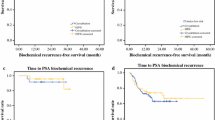Abstract
The aim of this cross-sectional study was to compare single with repeated high-intensity focused ultrasound (HIFU) treatment in patients with localized prostate cancer, regarding treatment-related morbidity. A number of 223 consecutive patients with localized prostate cancer were treated with HIFU. Among them, 174 (78%) patients had one treatment, while 49 (22%) needed a second treatment. The patients’ status and treatment-related side effects were followed up. The complications rates after one HIFU in 223 patients were: urinary tract infection 0.4%, chronic pelvic pain 0.9%, infravesical obstruction 19.7%, stressincontinence 7.6%, impotence 49.8%. Among the 49 patients who received a second HIFU therapy, the cumulative incontinence rate (12.2%; P = 0.024) and cumulative impotence rate (55%; P < 0.001) were significantly increased. Although there is an increase in morbidity if transrectal HIFU is repeated, the risk of side effects related to additional HIFU sessions in the case of primary treatment failure is still low.



Similar content being viewed by others
References
Barry MJ, Fowler FJ Jr, O’Leary MP, Bruskewitz RC, Holtgrewe HL, Mebust WK et al (1992) The American Urological Association symptom index for benign prostatic hyperplasia. The Measurement Committee of the American Urological Association. J Urol 148(5):1549–1557
Blana A, Walter B, Rogenhofer S, Wieland WF (2004) High-intensity focused ultrasound for the treatment of localized prostate cancer: 5-year experience. Urology 63(2):297–300
Chaussy C, Thueroff S, Rebillard X, Gelet A (2005) Technology insight: high-intensity focused ultrasound for urologic cancers. Nat Clin Pract Urol 2(4):191–198
Chaussy CG, Thuroff S (2000) High-intensive focused ultrasound in localized prostate cancer. J Endourol 14(3):293–299
Chen L, ter Haar HG, Hill CR (1997) Influence of ablated tissue on the formation of high-intensity focused ultrasound lesions. Ultrasound Med Biol 6:921–931
Curiel L, Chavrier F, Gignoux B, Pichardo S, Chesnais S, Chapelon JY (2004) Experimental evaluation of lesion prediction modelling in the presence of cavitation bubbles: intended for high-intensity focused ultrasound prostate treatment. Med Biol Eng Comput 42(1):44–54
Gelet A, Chapelon JY, Bouvier R, Pangaud C, Lasne Y (1999) Local control of prostate cancer by transrectal high intensity focused ultrasound therapy: preliminary results. J Urol 161(1):156–162
Gelet A, Chapelon JY, Bouvier R, Rouviere O, Lasne Y, Lyonnet D et al (2000) Transrectal high-intensity focused ultrasound: minimally invasive therapy of localized prostate cancer. J Endourol 14(6):519–528
Gelet A, Chapelon JY, Bouvier R, Rouviere O, Lyonnet D, Dubernard JM (2001) Transrectal high intensity focused ultrasound for the treatment of localized prostate cancer: factors influencing the outcome. Eur Urol 40(2):124–129
Gelet A, Chapelon JY, Bouvier R, Souchon R, Pangaud C, Abdelrahim AF et al (1996) Treatment of prostate cancer with transrectal focused ultrasound: early clinical experience. Eur Urol. 29(2):174–183
Huber P, Debus J, Jenne J, Jochle K, van Kaick G, Lorenz WJ et al (1996) Therapeutic ultrasound in tumor therapy. Principles, applications and new developments. Radiologe 36(1):64–71
Lerner SE, Blute ML, Zincke H (1995) Critical evaluation of salvage surgery for radio-recurrent/resistant prostate cancer. J Urol 154(3):1103–1109
Stamey TA (1973) Endoscopic suspension of the vesical neck for urinary incontinence. Surg Gynecol Obstet 136(4):547–554
Stolzenburg JU, Rabenalt R, Do M, Ho K, Dorschner W, Waldkirch E et al (2005) Endoscopic extraperitoneal radical prostatectomy: oncological and functional results after 700 procedures. J Urol 174(4 Pt 1):1271–1275
Thuroff S, Chaussy C, Vallancien G, Wieland W, Kiel HJ, Le DA et al (2003) High-intensity focused ultrasound and localized prostate cancer: efficacy results from the European multicentric study. J Endourol 17(8):673–677
Uchida T, Sanghvi NT, Gardner TA, Koch MO, Ishii D, Minei S et al (2002) Transrectal high-intensity focused ultrasound for treatment of patients with stage T1b-2n0m0 localized prostate cancer: a preliminary report. Urology 59(3):394–398
Wei JT, Dunn RL, Marcovich R, Montie JE, Sanda MG (2000) Prospective assessment of patient reported urinary continence after radical prostatectomy. J Urol 164(3 Pt 1):744–748
Workshop Committee of the National Institute of Diabetes and Digestive and Kidney Disease (NIDDK). 7-12-1995. Chronic Prostatitis Workshop, Bethesda
Author information
Authors and Affiliations
Corresponding author
Rights and permissions
About this article
Cite this article
Blana, A., Rogenhofer, S., Ganzer, R. et al. Morbidity associated with repeated transrectal high-intensity focused ultrasound treatment of localized prostate cancer. World J Urol 24, 585–590 (2006). https://doi.org/10.1007/s00345-006-0107-x
Received:
Accepted:
Published:
Issue Date:
DOI: https://doi.org/10.1007/s00345-006-0107-x




